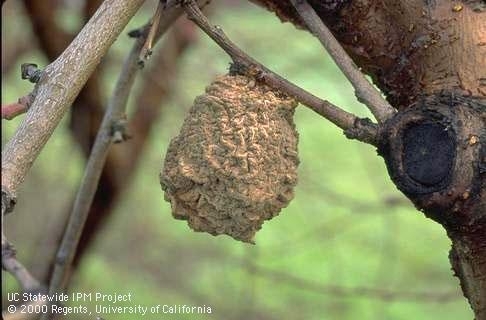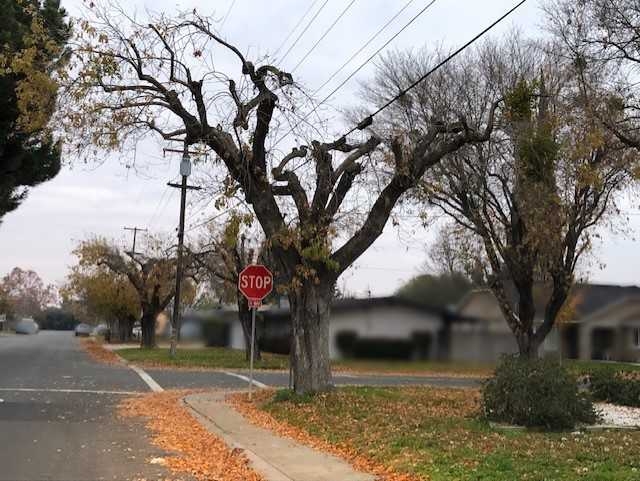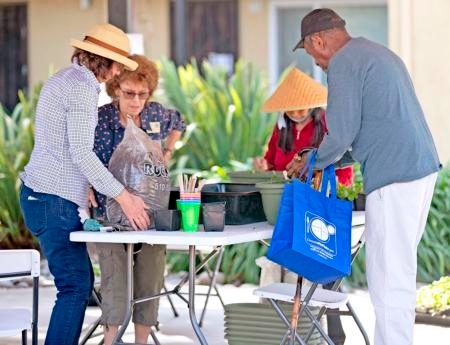Winter is the time of year when many people prune their deciduous fruit trees. However, did you know that now is not the right time to prune apricot and cherry trees?
In the past, home gardeners were advised to prune stone fruit trees (cherries, apricots, plums, peaches, and nectarines) after trees lose their leaves and go dormant. However, cherry and apricot trees are more likely to be attacked by certain diseases that can be spread by rain.
Gardeners who prune cherry and apricot trees during winter create wounds that may be invaded by fungal and bacterial canker diseases. Symptoms show up in spring and summer, when infected tree limbs wilt and suddenly die with their leaves still attached, or when bark becomes discolored and limbs produce an amber-colored ooze.
This year, wait to prune apricot and cherry trees until late spring or early summer. For more information about fruit trees, visit The California Backyard Orchard.
- Author: Anne E Schellman
Have you ever seen a tree that looks like it got a bad haircut? Or was just plain unattractive? Chances are this tree was pruned incorrectly using a practice called topping. Topping is the harmful practice of cutting tree branches to stubs, causing the resulting growth to become bushier and more susceptible to breakage during storms.
In winter, the results of tree topping are easier to see. Instead of topping, consider the form of the tree and picture how you want it to look when you are finished. Here are a few things to know before you start:
- Pruning cuts create a new direction for a tree to grow.
- There are three types of pruning cuts—a thinning or reduction cut, a removal cut, and a heading cut. Each is distinctly different and is used to accomplish unique objectives
- If you prune correctly, you can “train” a young tree into an attractive form.
- Pruning to establish a strong and attractive form is best done during the first 3-5 years of a tree's life.
- Reducing the size of a large tree can be done but is usually best done by an ISA certified arborist.
- Incorrectly pruning certain fruit trees can result in trees that don't bear fruit!
Here are some resources that describe the best methods to prune landscape trees and fruit trees.
Landscape Trees
Training young trees
Thin, don't top mature trees
Pruning landscape trees
Fruit Trees
The California Backyard Orchard website lists fruit trees by species and includes pruning tips for both deciduous and evergreen fruit trees.
- Author: Ed Perry
Many gardeners are interested in knowing how winter temperatures affect garden pests. The hope is that following a cold winter–such as this year–fewer pests will survive to plague the garden. Unfortunately, both insect pests and plant diseases have ways of surviving our harshest winters. However, there are some things that you can do to lessen potential pest problems, mostly by eliminating the places where pests and disease may overwinter.
Although a few pests can migrate great distances, many come from sources within your garden or nearby areas, surviving on weeds, in crop debris, as pupae in soil, or as seeds, spores or eggs. You can also unknowingly bring some pests into your garden on infested transplants or contaminated soil or equipment.
![Codling moth larvae inside a fruit. [Credit: Jack Kelly Clark, UC IPM] Codling moth larvae inside a fruit. [Credit: Jack Kelly Clark, UC IPM]](http://ucanr.edu/blogs/StanislausSprout/blogfiles/57017.jpg)
Good common-sense sanitation practices will help to eliminate overwintering garden pests. In your fruit trees, be sure to remove and destroy old fruit “mummies” hanging in trees and pick up and destroy any fallen nuts. Old fruits and nuts often contain pests such as codling moths. It's also very important to get rid of pruned branches, especially those from your fruit trees, that might be infested with disease or borers. Bark beetles may emerge from infested branches in late winter or early spring, so be sure to dispose of prunings as soon as possible. Don't forget to treat your fruit trees, especially peach and nectarine trees, with fungicide sprays to prevent spring diseases such as peach leaf curl; oil sprays applied now will also help to control overwintering insect and mite pests on deciduous trees.
Also, remove any weeds around your garden well before planting any new crops. Not only do weeds produce seeds that may find their way into your garden, but they are also likely to harbor numerous migrating pests. For instance, cutworms, earwigs, stink bugs, thrips and certain viruses carried by aphids and leafhoppers are all pests associated with weedy areas. If you wait until your garden is planted before destroying these weeds, the pests will move into your crops. Waiting for the weeds to dry out naturally will also encourage pest migrations. Besides, it's easier to control weeds when they're seedlings, rather than waiting until they've matured and set seeds.

Good sanitation also means making sure the planting stock you're using is free of pests. Check transplants or other greenhouse stock for aphids, diseases, nematodes and other pests. Use certified seed or stock if available. Make sure any organic soil amendments you use are free of weed seeds and pathogens, and don't move soil infested with nematodes, Bermudagrass stems, or nutsedge tubers to other parts of your garden. If you're not sure whether the soil is infested with pests, it's best to not take the chance. Also, clean equipment before moving it from infested areas.
Always be sure plant debris, particularly residue from previous vegetable crops, is completely decayed or removed before planting a new crop. A good way to destroy most crop and weed residues around your garden is by composting. Composting destroys most of the pests that may be harbored in the residues.
You can download a free copy of Composting is Good for Your Garden and the Environment to learn more.
Ed Perry is the emeritus Environmental Horticultural Advisor for University of California Cooperative Extension (UCCE) in Stanislaus County.
- Author: Anne Schellman
You may have heard about the Asian citrus psyllid (ACP), a tiny insect that spreads a disease called Huanglongbing (HLB) or citrus greening. Infected citrus tree fruits remain green and do not ripen, and the fruit tastes bitter. Diseased trees decline and eventually die. There is no cure.
HLB is fatal to all citrus trees, including lemon, lime, orange, mandarin, grapefruit, pomelo, and relatives like kumquat. Host plants that can harbor the pest include orange jessamine and curry leaf.
In Florida, the insect was found in 1998, and the disease was later detected in 2005. Due to HLB and other factors, Florida's citrus industry has been reduced in half over the past decade.
In 2008, the psyllid was found in Los Angeles, and several years later, it made its way to Stanislaus County where it was found on four different residential properties. One finding was in Modesto, another in Oakdale, and two were in Turlock. So far, the disease has only been found in Southern California. To see where ACP and HLB have been found to date, visit this map https://ucanr.edu/sites/ACP/Distribution_of_ACP_in_California/.
So far, trees in Stanislaus County are safe. Unfortunately, the psyllid and disease may advance north. But there are things you can do to help stop this disease.
How You Can Help
Watch this video to learn more about Asian citrus psyllid and Huanglongbing to learn more. You can also visit https://ucanr.edu/sites/ACP/Homeowner_Options/
How UCCE Master Gardeners Will Help
The UCCE Master Gardeners will educate the public about ways to stop the spread of the psyllid through the following messages:
- Purchase citrus from reputable nurseries. Don't accept tree cuttings or budwood from friends or relatives.
- Do not move plants out of quarantined areas.
- If you prune or cut down a citrus tree, dry out the green waste or double bag it to ensure live psyllids can't be moved to another region.
- Control ants in and near citrus trees using bait stations. Ants protect ACP from natural predators.
- Look for ACP on the soft, new succulent leaves of citrus trees and host plants.
- If you believe you have found the psyllid on your plant, call the California Department of Food and Agriculture (CDFA) Hotline immediately at 1-800-491-1899.
For resources in Spanish, visit Noticias en espanol.
Want to become a UCCE Master Gardener or learn more about the program? Visit our website at https://ucanr.edu/sites/stancountymg/
---
Who are the UCCE Master Gardeners?
UCCE Master Gardeners are residents in the community trained by University advisors and experts using science-based information. They take a weekly class for 6 months and learn about a variety of topics, including soils, horticulture, vegetable gardening, composting, fruit trees, and many more! After passing an exam, the trainees become certified UC Master Gardeners, ready to answer your questions about home gardening.
You may see the UCCE Master Gardeners at events such as farmer's markets, the library, the fair, or a school garden. They will also be at the UCCE office each week, available to answer your questions.
UCCE Master Gardener Focus
The UCCE Master Gardener Program plans to address local issues related to reducing green waste, conserving water, integrated pest management (IPM), and sustainable landscaping.
The first group of trainees will start their classes in January and finish in June, ready to volunteer. In the meantime, you can still bring your pest or gardening questions to the UCCE office at the Agricultural Center at 3800 Cornucopia Way, Suite A in Modesto. Or call (209) 525-6800. The office is open M-F 8:00 a.m. to 4:30 p.m.
Blog Focus
Posts for this blog will include seasonal gardening tips, posts on how to solve pest problems, and notices for events featuring the UCCE Master Gardeners.
Interested in Becoming a UCCE Master Gardener?
Visit https://ucanr.edu/sites/stancountymg/ to read about the program in detail. Our next class will start in January of 2020. Click on the big yellow button to fill out a survey to be contacted when sign ups for the class are available.

![Oozing from fungal infection in cherry that was pruned during the cool season. [Credit: Chuck Ingels, UCCE Sacramento] Oozing from fungal infection in cherry that was pruned during the cool season. [Credit: Chuck Ingels, UCCE Sacramento]](http://ucanr.edu/blogs/StanislausSprout/blogfiles/57473.jpg)

![The Asian citrus psyllid is small, about the size of a gnat. [Credit: M.E. Rogers, University of Florida] The Asian citrus psyllid is small, about the size of a gnat. [Credit: M.E. Rogers, University of Florida]](http://ucanr.edu/blogs/StanislausSprout/blogfiles/57019.jpg)

